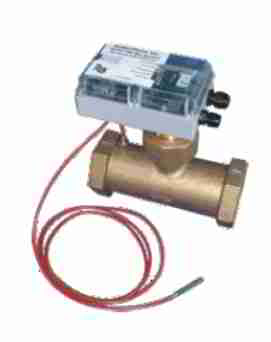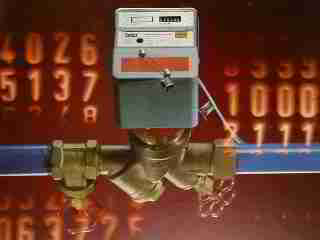 BTU Monitoring for Heating Cost Apportionment
BTU Monitoring for Heating Cost Apportionment
- POST a QUESTION or COMMENT about about BTU monitoring & heating cost apportionment methods for rental or multi-occupant buildings..
BTU monitoring for heating cost apportionment: this article describes BTU monitoring equipment & other means of heating cost apportionment across multiple rental apartments or other multiple dwellings when served by a common heating system.
We describe several approaches used to assign a share of heating cost to individual building occupants or tenants, ranging from square footage to heat-on-timers to much more accurate BTU usage monitoring equipment that tracks actual heating energy used by each heating zone or occupied area.
Shown at page top is a 1980's vintage Ista (now Istec Energy Systems) BTU monitoring device.[5]
InspectAPedia tolerates no conflicts of interest. We have no relationship with advertisers, products, or services discussed at this website.
- Daniel Friedman, Publisher/Editor/Author - See WHO ARE WE?
Heating Cost Apportionment Problems & Solutions for Rental Apartments in the U.S. & Europe
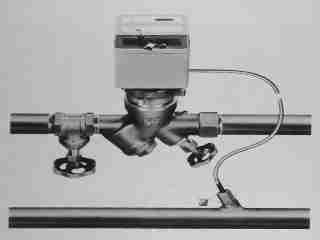
How can we best assign a fair share of heating costs to individual apartments, tenants, rental or other units in a multi-occupant building?
Here we describe methods to assign a fair share of heating costs to building occupants according to their actual demand for heat.
Separately at at AIR LEAK DETECTION TOOLS and also at BASEMENT HEAT LOSS DETECTION we discuss the problem of heat loss and uneven heating particularly in two-story multi-family homes with an upstairs and downstairs tenant and a single heating system with a single thermostat located on the first floor.
This problem is related to fair assignment of heating costs. The upstairs tenants are too hot and the downstairs tenants are too cold.
The illustration (left) shows an Ista BTU monitor design from 1985, one of several heating cost apportionment devices discussed along with their modern (and much less costly) counterparts shown in the article below. Ista is now Istec Energy Systems.
In Europe BTU monitoring and accurate heating cost apportionment among tenants is required by law, but this is not the case in the U.S. nor Canada. Nevertheless building owners are increasingly faced with tenants who want to be sure that individuals are only being taxed to pay their fair share of building heating costs.
Energy Use Monitoring: Hot Water Heat, Steam Heat & Warm Air Heat
Hot water - hydronic heat BTU monitoring & energy consumption measurement: most of the energy use or BTU use monitoring devices we have observed are designed to measure fluid temperature and fluid flow rate (presumably hot water moving in hydronic heating system pipes through circuilators, possibly zone valve, and radiators or heating baseboards or radiant heat tubiing).
Measuring both flow rate (lpm or gpm) and temperature allows a reasonably accurate measure of the rate at which BTUs are being requested by an individual heating zone, area, apartment or tenant.
Warm air heat use by individual zones could be measured by a similar approach but it's more difficult to do so with precision. More likely a building manager will seek to simply measure heat-on demand by individual zone, approximating BTU consumption by noting the duration of calls for heat at individual thermostats or individual zone dampers (in the open position).
Slowing warm air movement between floors by insulation and sealing may be helpful, but an optimum solution includes separate heating zones and zone controls, or even separate heating systems entirely, permitting accurate heating cost apportionment among the tenants.
Steam heat use by individual zones or tenants may be measurable by indusrtrial process equipment, but as you'll read in our specific device notes below, costs for this approach can be significant, in thousands of dollars per zone. A steam heat monitoring device from GE Panametrics (GE Panaflow MV80) retails at prices starting around $2000. U.S.
Four Approaches to Heating Cost Apportionment among rental units
BTU Monitoring Equipment may be required by law for rental units in Europe where a common heating system is used to heat (or A/C to cool) multiple apartments in a single building but those devices are seeing increased interest in the U.S. as well.
1. Simple Heating Cost Apportionment by Floor or Unit Area
Heating cost apportionment by square feet or by floor is often used in two family homes in the U.S. The landlord simply divides the heating bill in two if the two rental units occupy about the same square footage, or s/he may apportion heating costs by actual square footage of the home. The inaccuracies of this approach can be significant. For example, a second floor apartment is receiving some heat from the floor below; or one tenant may keep their heating thermostat set lower than another.
2. Heating Cost Assignment using Zone Valve Timers
Heating zone-on timers, a "budget" approach that does not accurately measure actual BTU consumption has been used by some of our readers and clients. The appeal of this less accurate approach is that the installation and equipment to simply keep track of the length of time that a heating zone or heating thermostat is calling for heat is often less costly and simpler to install than true BTU monitoring equipment.
A zone valve is a small low-voltage electric motor that is operated by a room thermostat corresponding to that individual heating zone or area - a loop of heating pipe routed through one or more rooms. The thermostat calls for heat, the zone valve opens, an end switch turns on a circulator (or boiler depending on installation details). When the thermostat is satisfied it stops calling for heat which in turn closes the zone valve.
Accuracy of heating zone timers for BTU monitoring
Because the operation of the zone valve is by a simple low-voltage electrical circuit, it's not difficult to construct a timer that monitors the "heat on" elapsed time for that zone. But without measuring temperature and flow, the simple "heat on" measure is inaccurate and crude compared with true BTU monitoring.
For example just consider two different heating zones both of which operated for an hour.
- Zone one heats the entire first floor of a home - 1525 square feet.
- Zone two heats a single room, say an second floor study totaling 500 square feet, in the same building.
It will be apparent that simply measuring heat-on without considering at least the square footage is close to meaningless in assigning heating costs. Even measuring square footage does not accoiunt for differences in heat loss between two areas. This approach is not approved for European rental units.
3. Fuel Demand Meters Monitor Fuel Consumption not BTU Consumption
Fuel demand meters: are used where multiple individual heating appliances are installed and the building owner/manager wants to monitor fuel consumption by individual heating appliance. Example - Johynson fuel demand meter.
4. BTU Usage or BTU Consumption Measurement Using Monitoring Devices
 Actual BTU usage, a more precise approach, monitors are typically devices that measure temperature and flow rates of hot water in individual heating zones. This approach is the most accurate means of determining actual energy consumption or heat usage in differnt building heating zones, occupancies or by different tenants.
Actual BTU usage, a more precise approach, monitors are typically devices that measure temperature and flow rates of hot water in individual heating zones. This approach is the most accurate means of determining actual energy consumption or heat usage in differnt building heating zones, occupancies or by different tenants.
BTU meters available in North America have come a long way since we first reported on this topic back in 1985 (illustration at page top).
Currently several manufacturers produce a range of BTU monitoring equipment suitable for mounting on hydronic heating system piping and capable of giving BTU consumption measurement data accurate enough to satisfy both E.U. requirements and those in other countries.
Shown at left is a contemporary BTU monitoring device, the GF Signet 8900 Multi-Parameter controller produced by Georg Fischer. This single device, equipped with multiple sensors, can monitor multiple channels simultaneously.
When we first looked at this equipment back in 1985 there was a bit of sticker-shock as quite a few devices were clearly designed for industrial applications, not residential or apartment use.
For example in 1985 a Series 450 Energy BTU flowmeter by Controlotron cost roughly $7,400. per heating zone (at that time). Happily engineering progress including the use of VLSI circuitry has led to new, less costly devices from these and other manufacturers as we illustrate below. The Badger Model 380 BTU meter sdetailed in the text below retails at prices starting at $560.U.S.
For measuring & monitoring electrical energy consumption
see ELECTRICAL POWER ANALYZERS
Sources of BTU Monitoring Equipment
- Badger Meter, 3050 Series BTU monitor, This is an industrial -grade BTU monitoring device. Quoting from the company's website: Provides an accurate measurement of total thermal energy along with temperature and liquid flow in closed pipe systems.
The Btu meter has all of the features and programming flexibility of the Model 3000 flow monitor with the added ability to accept temperature inputs from thermistors or rtds. The Badger Model 380 BTU meter (above left) uses an impeller mounted in the fluid flow stream of the pipe for precise measurements little affected by aeration or debris particles.
For a wider range of piping diameters and flow rates the company also ffers Badger's 250-228 Series of flow and BTU monitoring equipment. [4] - Controlotron Corporation (Hauppage, NY, Tel. 516-231-3600) produces clamp-on ultrasonic flow meters that may be adapted to heating media usage monitoring. See our caveats below about accuracy of different approaches to BTU monitoring. [6]
- Dynasonics clamp-on ultrasonic flow meters and energy use meters include the TFX Ultrasonic Flow Meter (about $1800. U.S.) [10]
- GE Infrastructure Sensing (previously GE Panametrics) produces a wide range of flow sensing and BTU monitoring devices including ultrasonic flow meters, including the GE Panametrics Digital Flow DF868, and other models ranging in price from around $2000. U.S. for the GE Panametrics PanaFlow MV80 for steam and gas applications to the GE Panametrics Transport PT878 (around $5,500. U.S.). GE Panametrics also produces portable ultrasonic flow meters that can be purchased or rented, such as the PT-878 Portable Ultrasonic Flow Meter. [9]
- GF Signet (Georg Fischer) produces the GF Signet 8900 Multi-Parameter controller [illustrated above on this page] that measures a variety of parameters beyond just flow and temperature (needed for BTU or energy consumption measurement) including pH, ORP, conductivity, and pressure. (Starting at $770.U.S.). Availble from Instrusmart, tel: 1-800-884-4967 [8]
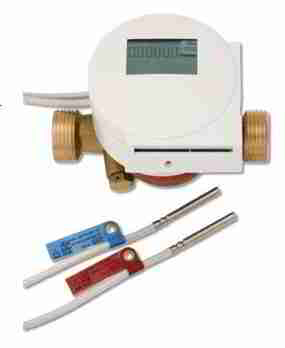
- Istec BTU Meter Measures, from Istec Energy Systems Corporation, (offices in countries world-wide) provides BTU monitors intended for mounting on individual heating zone lines [photo above left]. Ista Energy Systems in the U.S. can be contacted at ista North America
3655 North Point Parkway, Suite 250
Alpharetta, GA 30005-2025
Phone: (678) 336-2200.
The Istec Model 5201 BTU meter shown in this image [at left] from the company's product literature, is intended for connection to 3/4" diameter piping (typical of hydronic heating systems] and is described by Istec Energy Systems as
"... [providing] a simple and cost effective solution for tenant sub-metering and energy monitoring. Data from the 5201 BTU meter can be read manually from the integral LCD, downloaded to a spreadsheet with the Chip Card, or accessed via a computer over the internet using the M-bus module & hub options."
The Ista BTU meter [shown in images at the top of this article] is comprised of a flow meter, an electronic calcuilating unit, temperature sensors, a power supply and other features. [1985 catalog data. Newer products from Istec Energy Systems have other features.] The company's current product line includes the sensonic® II, and sensonic® II, far more compact than what we saw in 1985. [5]
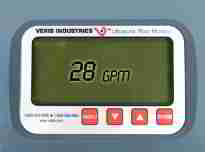
- Johnson Fuel Demand Meter
- Veris Industries, produces an FST and FSTR series ultrasonic flow & energy use BTU meter [image at left], [clamp-on ultrasonic sensing] that the company says can obtain accurate readings from "outside the pipe".
The Veris ultrasonic flow or BTU monitoring product series is designed for "commercial and industrial installations involving clean liquids or liquids containing small amounts of suspended solids or aeration". Veris Tel: 800.354.8556 [7]
Accuracy of BTU Monitoring Equipment
The accuracy of energy monitoring by counting BTU consumption may be affected by the methodology used. More costly to construct and install, actual physical flow monitoring that uses a paddle or wheel sensor mounted in the heating water flow path can provide a very accurate measurement of flow-rate of water in liters or gallons per minute. That data combined with constant monitoring of water temperature can give accurate results. But having to place moving parts in the flow path means expensive equipment and risk of technical problems from clogging, debris &c.
Potentially similarly accurate BTU monitoring may be achieved by ultrasonic devices that clamp on to a pipe to measure flow rate of fluid inside the pipe. But these methods two can produce results that vary in precision depending on just what is in the flowing water (or other liquid) such as entrained air or debris.
Watch out: be sure to discuss your BTU monitoring application with the manufacturer. Some of energy use monitoring devices, particularly those relying on ultrasonic sensors rather than physical flow measurement by impeller, are sensitive to air or contaminants in the fluid flowing through the heating distribution piping. For example, Veris notes: "ommercial and industrial installations involving clean liquids or liquids containing small amounts of suspended solids or aeration".
Reader Question: Is there a measuring instrument that can be put on the zone valves to measure the amount of heat used by each apartment ?
I found your site on line. I have a 4 unit house that I live in. Each apartment has it's own heating zone. Is there a measuring instrument that can be put on the zone valves to measure the amount of useage each apartment uses? I would greatly appreciate a response. H.R. 2/20/2012
Reply:
There are heat-usage monitoring devices used (e.g. throughout Europe) that accurately track how much heat is used by each heating zone or apartment by measuring BTU consumption. What's needed to be even close to accurate is heating water flow rate (lpm or gpm), flow time, and temperature.
In the U.S. where heating cost apportionment is not required by law, some folks make a crude stab at apportioning costs by installing a simple (less expensive) timer that monitors how much of the time a particular zone is calling for heat. There are obvious reasons that a simple approach may be unfair, such as differences insulation, heat distribution, rates of heat loss, in different areas.
We discuss the alternative means of measuring or guessing at how to apportion building heating cost among its tenants in the article above.
...
Continue reading at ENERGY SAVINGS RETROFIT OPTIONS or select a topic from the closely-related articles below, or see the complete ARTICLE INDEX.
Or see these
Recommended Articles
Suggested citation for this web page
BTU MONITORS & HEATING COST APPORTIONMENT at InspectApedia.com - online encyclopedia of building & environmental inspection, testing, diagnosis, repair, & problem prevention advice.
Or see this
INDEX to RELATED ARTICLES: ARTICLE INDEX to HEATING SYSTEMS
Or use the SEARCH BOX found below to Ask a Question or Search InspectApedia
Ask a Question or Search InspectApedia
Try the search box just below, or if you prefer, post a question or comment in the Comments box below and we will respond promptly.
Search the InspectApedia website
Note: appearance of your Comment below may be delayed: if your comment contains an image, photograph, web link, or text that looks to the software as if it might be a web link, your posting will appear after it has been approved by a moderator. Apologies for the delay.
Only one image can be added per comment but you can post as many comments, and therefore images, as you like.
You will not receive a notification when a response to your question has been posted.
Please bookmark this page to make it easy for you to check back for our response.
IF above you see "Comment Form is loading comments..." then COMMENT BOX - countable.ca / bawkbox.com IS NOT WORKING.
In any case you are welcome to send an email directly to us at InspectApedia.com at editor@inspectApedia.com
We'll reply to you directly. Please help us help you by noting, in your email, the URL of the InspectApedia page where you wanted to comment.
Citations & References
In addition to any citations in the article above, a full list is available on request.
- In addition to citations & references found in this article, see the research citations given at the end of the related articles found at our suggested
CONTINUE READING or RECOMMENDED ARTICLES.
- Carson, Dunlop & Associates Ltd., 120 Carlton Street Suite 407, Toronto ON M5A 4K2. Tel: (416) 964-9415 1-800-268-7070 Email: info@carsondunlop.com. Alan Carson is a past president of ASHI, the American Society of Home Inspectors.
Thanks to Alan Carson and Bob Dunlop, for permission for InspectAPedia to use text excerpts from The HOME REFERENCE BOOK - the Encyclopedia of Homes and to use illustrations from The ILLUSTRATED HOME .
Carson Dunlop Associates provides extensive home inspection education and report writing material. In gratitude we provide links to tsome Carson Dunlop Associates products and services.


